Soy sauce chicken (See Yao Gai/Si Yau Kai / 豉油鸡) is a famous Cantonese cuisine that is easy to prepare. The flavor is exceptional, achieved by using the top-quality premium soy sauce and poaching at a sub-boiling temperature. It is a popular traditional recipe during Chinese New Year, but I make it regularly since it is so tasty.
Other items hanging at the Chinese restaurants under the heat lamps are barbecue pork (char siu 叉 烧 ), roast pork 烧肉, and roast chicken are all involved open fire (we can use the oven at home to prepare small quantity). Chinese sausage and other ‘waxed’ items are cured meat.
While there are many choices at the typical 烧蜡/Siu mei/Siu lap Chinese restaurant, soy sauce chicken is the only one prepared by braising, which is healthier and straightforward. As such, soy sauce chicken does stand out among other delicacies in the restaurant.
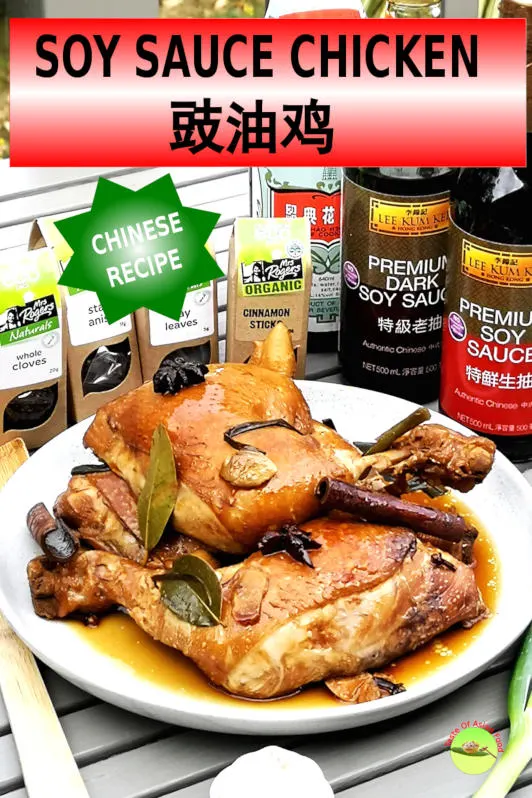
Note: This post may contain affiliate links. Please read my privacy policy for more info. I may receive commissions for purchases made through links in this post. As an Amazon Associate, I earn from qualifying purchases.
How to cook soy sauce chicken
Here is a detailed explanation of preparing the Chinese soy sauce chicken. You will get the exact restaurant taste by following this recipe.
1. Marinate the chicken (optional)
Since I am using the chicken leg quarters in this recipe, marinating is unnecessary. Using chicken breasts, legs, or wings is easier to handle than the whole chicken at home. Boneless thighs may not be a good option because the bones have loads of flavor themselves.
If you are using a small chicken up to 1kg, the meat is not as thick as the larger chicken, and marination is unnecessary. The flavor from the braising sauce can penetrate deep into the bone just by poaching it. However, if you choose a larger chicken, I would suggest marinating it first to ensure that the flavor penetrates. Large chicken is best to marinate overnight for maximum effect,
Another point to consider is if you plan to eat the chicken later (or overnight), the flavor from the braising liquid should have sufficient time to seep into the meat, in which marinate will not be necessary.
2. Prepare the braising liquid
The primary ingredient of the braising liquid is light soy sauce. Therefore, the quality of the light soy sauce is critical for the outcome of the soy sauce chicken. Therefore, I suggest using a good quality light soy sauce for this recipe.
Dark soy sauce is of secondary importance in this recipe. The main purpose of dark soy sauce is to add color and the caramelized sweet taste, not so much of the umani flavor. The darker color is due to the longer fermentation while making the soy sauce.
Rock sugar is commonly used in braising and making desserts among the Chinese. However, I find that regular white sugar or brown sugar yields a similar result. It says that rock sugar will result in a smoother texture, but the difference is not noticeable in reality.
Ginger, garlic, and scallion (green onions) are the triumvirate of aromatic ideal for the chicken. This combination is also used to poach the whole chicken and steam the entire chicken. It would be best to saute them until aromatic before adding them to the braising liquid to deliver maximum flavor.
The spices for the cooking liquid are bay leaves, star anise, cinnamon sticks, and cloves. This combination is my preference, and you can have your own mix. Some other common species are cumin and peppercorns. You can add these items to the recipe and omit some spices you do not like.
Variations: You can also include some sesame oil if you like its flavor. Another option is to add some Chinese rose wine or other Shaoxing wine into the braising liquid.
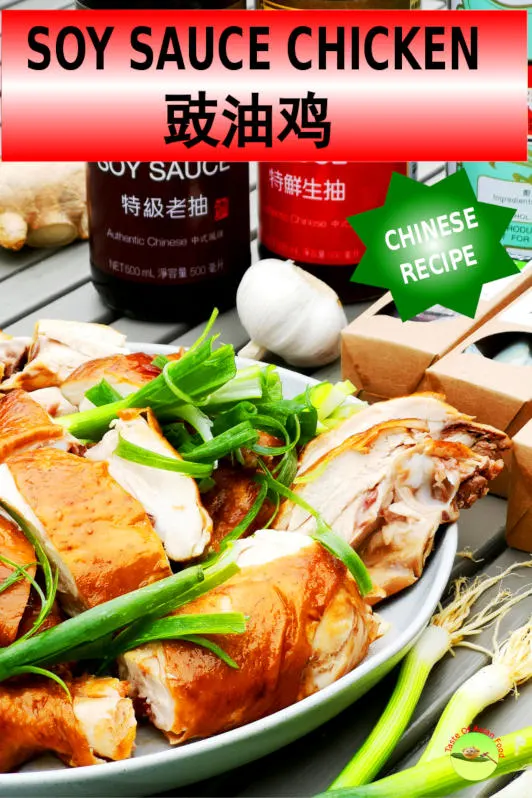
3. Poach the chicken
The crucial step to ensure the chicken meat is tender is to poach it at the sub-boiling point until it is just cooked.
Here are the steps:
- If you are cooking the whole chicken, clean it by removing the innards, then use plenty of water to flush the cavity until the water runs clear. You can refer to the steamed whole chicken recipe (a.k.a. White cut chicken)for the details. For convenience, I am using chicken whole legs today, and therefore only need to clean and drained.
- Boil a pot of water sufficient to submerge the chicken. Choose a stockpot, instant pot, or Dutch oven with the size which is just fit to put the chicken pieces so that the amount of water required is minimum.
- Once the water is boiling, add the sauteed ginger, garlic, scallion, and all other ingredients in the recipe into the hot water.
- Place the chicken into the boiling liquid.
- Check the water level to ensure the chicken is fully submerged in the water. You may need to add enough water to cover the chicken. (Note: I am cooking the chicken while visiting my son in New Zealand. Since they do not have a pot that is large enough to submerge all the chicken legs completely, I have to turn the chicken legs over halfway during cooking to ensure that they are evenly cooked. You can refer to the embedded video for the detail.)
- Bring the braising liquid to a boil. Then reduce the heat until the liquid is barely boiling. Keep the temperature at the sub-boiling point and poach the chicken for twenty minutes.
- After twenty minutes, switch off the stove and cover the pot with a lid. Let the braising liquid cool down slowly while keeping the chicken in it.
- After fifteen minutes of poaching at the sub-boiling point, remove the chicken. (Note: You need a longer cooking time if you are poaching the entire chicken.)
- If you are poaching the whole chicken, keep the chicken upright to drain off the liquid in the cavity. Let it cool completely at room temperature before cutting.
4. Make the sauce with the poaching liquid
Below are a few ideas to use the extra sauce leftover after cooking. This soy sauce mixture is the master stock for making a variety of Chinese cuisine. Here are my suggestions:
- Make a dipping sauce for the chicken by reducing the poaching liquid. First, pour the poaching liquid through a wire mesh strainer to remove all the herbs and spices. Then, heat a portion in a pan to reduce the volume to half or until it becomes a thick, caramelized sauce. This sauce is ideal as the dipping sauce for the chicken.
- Prepare the tea eggs by using this liquid. Add the hard-boiled eggs and a packet of Chinese tea bags (or black tea) into the poaching liquid and let the eggs steep for at least haft a day. You can read the article on how to make the tea eggs for more details.
- The braising liquid can be reused to poach another chicken in the future. It is also ideal for braising pork and tofu. Making braised tofu with this soy sauce liquid is quick and easy since tofu absorbs the flavor quickly. Place the fried tofu (It is readily available in the store) in a pan with some braising liquid. Bring it to a boil over low heat and let the tofu absorb the sauce until it slightly thickens. Place the tofu on a plate and drizzle the sauce on it and garnish with spring onions.
5. Storage
You can keep the extra liquid for future use in an airtight container and freeze it. You can keep it for up to several months.
Soy Sauce Cicken
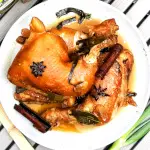
Soy sauce chicken (See Yao Gai/Si Yau Kai / 豉油鸡) is a famous Cantonese cuisine that is easy to prepare. The flavor is exceptional, achieving by using top quality premium soy sauce and poach at a sub boiling temperature.
Ingredients
- 1.5 kg whole chicken
Braising liquid:
- 250ml (1 cup) light soy sauce
- 60ml (4 tbsp) dark soy sauce
- 60ml (1/4 cup) Shaoxing wine
- 2 tablespoons sesame oil
- 90g (3 oz) sugar
- 2 bay leaves
- 3 star anise
- 2 cinnamon sticks (about 5-10 cm)
- 5 cloves
- Water sufficient to cover the chicken
Aromatics:
- 10 slices ginger
- 8 cloves garlic, smashed
- 2 stalks scallions, cut into 5cm sections
Instructions
- Clean the chicken whole leg and drain.
- Measure all the ingredients in the Braising liquid section and put it into a pot.
- Saute the ingredients in the Aromatic section until it turns fragrant. Add to the braising liquid.
- Bring the braising liquid to a boil. Put the chicken into the pot and add sufficient water until it covers the chicken.
- Adjust the heat until the liquid is barely boiling. Let the chicken poach in the liquid for twenty minutes.
- After twenty minutes, switch off the stove and cover the pot with a lid. Let the braising liquid cool down slowly while keeping the chicken poaching in it.
- After fifteen minutes of poaching, remove the chicken.
Recommended Products
As an Amazon Associate and member of other affiliate programs, I earn from qualifying purchases.
Nutrition Information:
Yield:
3Serving Size:
1Amount Per Serving: Calories: 1562Total Fat: 83gSaturated Fat: 22gTrans Fat: 0gUnsaturated Fat: 52gCholesterol: 468mgSodium: 953mgCarbohydrates: 40gFiber: 6gSugar: 5gProtein: 148g
This data was provided and calculated by Nutritionix on 1/29/2020

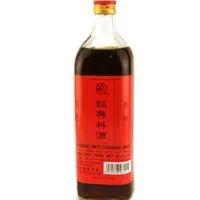
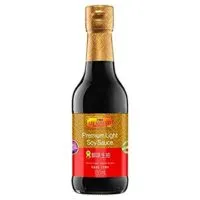
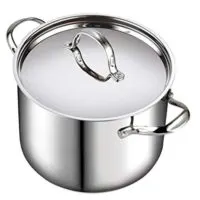
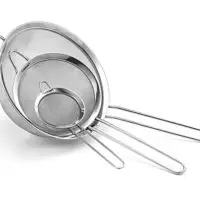
Chris
Monday 17th of February 2020
Amazing recipe. Thanks for the meticulous details. It really helps!
KP Kwan
Monday 17th of February 2020
You are welcome.
Chris
Monday 17th of February 2020
Just wanted to comment that your recipes are really Good! I cooked the soy sauce chicken for my mum who has high standards, and she approved ;) thank you for the detailed instructions and recipes!
KP Kwan
Monday 17th of February 2020
Hi Chris, It is my pleasure to share. Glad that your mum liked it :) KP Kwan
Eric Cheok
Monday 10th of February 2020
I will definitely try it. I love soya sauce chicken. Thank you.
Wee
Sunday 2nd of February 2020
The flavour is amazing, will definitely make it again.
KP Kwan
Monday 3rd of February 2020
Thanks and I hope you will like it.
KP Kwan
Friday 31st of January 2020
Hi, this is KP Kwan. I am happy to see you in this comment area, as you have read through my recipe. I am pleased to reply to any questions and comments as soon as possible